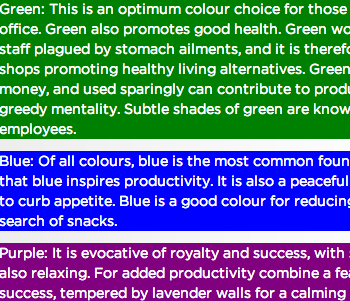Colour Psychology in the Office

An office move can be a great opportunity to promote your company brand and image. Office Removals Sydney are the premier moving company for assistance not only with moving, but also regarding placement of furnishings and important infrastructure to optimise office productivity. At some stage during the move, when staff understand the layout of the new space, it’s time to get creative and add colour to your office environment. The easiest way to do this is by painting. Understanding the psychology of colour can help you make suitable choices.
Red: This is a power colour, but is also known to disrupt performance due to being associated with danger. Red can be a very useful colour for restaurant signage and advertising as it is known to increase appetite. Keep unhealthy snacks at a distance from a red office.
Orange: Orange, reminiscent of sunshine and warmth, can induce feelings of enthusiasm. If you hold meetings and require a warm and inviting impression for clients and guests, orange could be a suitable colour. Try to use softer orange tones as bright orange can also signal warnings or danger.
Yellow: This is a happy colour, bringing a bright cheerful mood to a room. It is also known to boost energy and invigorate jaded senses. On the down side, a yellow that is too bright can cause eye strain, and subdued tones are advisable. Also, if you have small children visiting, or work in child care, avoid yellow as studies have revealed a tendency for babies to cry in yellow rooms.
Green: This is an optimum colour choice for those who want to create a tranquil office. Green also promotes good health. Green work places have fewer incidents of staff plagued by stomach ailments, and it is therefore a good colour for offices and shops promoting healthy living alternatives. Green also stimulates awareness of money, and used sparingly can contribute to productivity. In excess it may promote a greedy mentality. Subtle shades of green are known to reduce stress among employees.
Blue: Of all colours, blue is the most common found in offices. Studies have shown that blue inspires productivity. It is also a peaceful and calming colour, and is known to curb appetite. Blue is a good colour for reducing trips to the staff canteen in search of snacks.
Purple: It is evocative of royalty and success, with subtle shades of lilac and lavender also relaxing. For added productivity combine a feature wall of royal purple for success, tempered by lavender walls for a calming effect.
Pink: Subtle shades are office-friendly, whereas hot pink conjures up imagery of a children’s toy store full of dolls, creating a too-frivolous mood for most offices. It is a great colour to use sparingly as highlights or accents, as it can lighten a stressful office mood.
White: This can be the best choice for small office spaces, creating an illusion of greater space. It can also be incorporated in furniture choices for a more spacious but classy appearance.
Brown: Many older offices were traditionally very brown, from flooring to furniture and fixtures. This is a useful colour to create a steady, serious, and reliable atmosphere suited to businesses such as legal and accounting firms, where an outgoing personality is not usually expected.
Black: Although not usually associated with walls, black is fine as an accent colour in small doses, and can look quite classy combined with other colours. Some people avoid black due to negative association.
There is really no limit to colour scheme choices and combinations. By choosing a colour scheme that works for your office or industry you will create the right mood for clients and customers. Office Removals Sydney are experts at heavy lifting and furniture placement. Now it time for you to shine with the colour palate of your choice.
